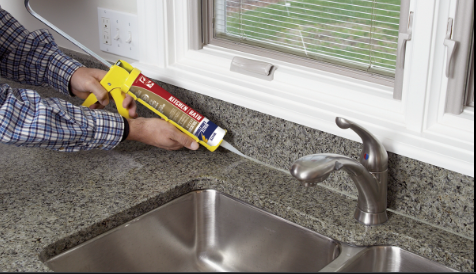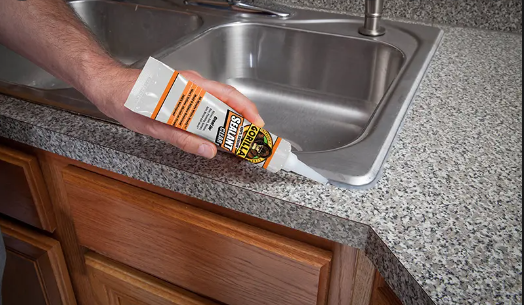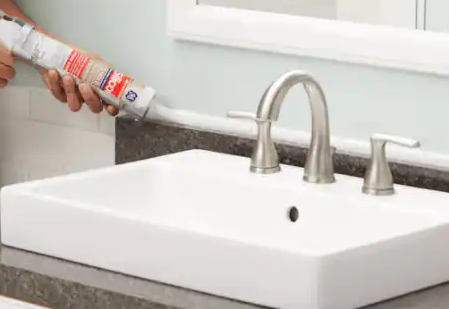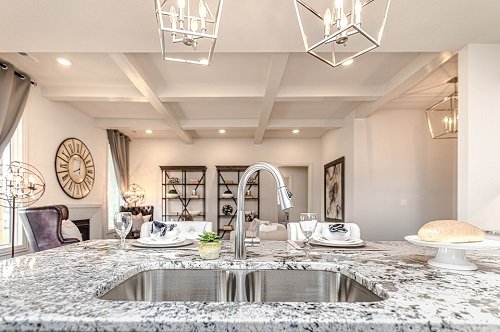Choosing between clear and white caulk is always challenging for many DIY enthusiasts. A wide variety of clear caulk often appear white during caulking and then dry clear. This scenario is prevalent with clear caulks with latex. If you apply the caulk to a clean, dry surface and allow it to fully dry, it will eventually turn from white to clear. But if you don’t let the caulk fully dry, it might retain a white, cloudy appearance. So, do you use white or clear caulk around a sink?
Clear caulk is commonly used in showers or kitchen sinks to seal the tiles, while the white caulk is mostly used to seal baseboards, roofing, and woodwork. Though both caulking options essentially work great in sinks, we highly recommend applying caulk according to the condition of the surface. So, here is a more detailed overview of what situations call for white or clear caulk.
What kind of Caulk Do You Use Around a Sink?
You’ll want to use a silicone-based caulk on any sink with a stainless or metal finish (such as those found in kitchens) or a porcelain sink (as you would on any other bathroom sink). But for a porcelain sink (common in bathroom spaces), a caulk made of latex-based materials will be a better fit.

Should You Use White or Clear Caulk Around a Sink?
Clear caulk is best for kitchens and bathrooms. It is not a permanent fix – it will look great regardless of the sealed surface’s color. Clear caulk is the best option for creating a neat, smooth seam that will not clash with nearby tiles, grout, or stone. Sometimes if you are not planning to paint over the caulk, using clear caulk is the best choice.
Here are the different scenarios where you can use white or clear caulk:
- Use clear caulk in the bathroom and kitchen sink
- Clear caulk is perfect for sealing fixtures on stone or tile, such as in showers or around kitchen sinks
- Use clear caulk if you don’t plan to paint over caulk.
- Use white caulk for sealing baseboards, siding, and trim
- White caulk is perfect if you will be painting over the caulk.
Choosing white caulk for caulking boards, trim, or other surfaces that will be painted later is best because it provides an ideal covering for all of these surfaces. White caulks are often designed to give you a smooth, paintable surface to begin with. And, since you’ll probably be painting over it anyway, white caulk is a great primer to use.
When Should You Use Clear Caulk?
Clear caulk is a versatile product that works well in many areas of the house. Only use white caulk to seal up gaps and cracks that may occur in various materials in your home, like wood trim, doors and windows, tiles in the shower and on the floor, and more.
Can You Apply Clear Silicone On top Of White Caulk?
Do not apply new caulk over old caulk. When you add clear silicone caulk to white caulk, you will have a messy-looking caulk that will not stick to the old caulk as well. You will see all the white caulk underneath. Silicone sealants will stay put on hard, smooth surfaces such as tile, metal, and stone. It is possible for white caulk to start to peel off after you apply silicone caulk to it.
- Don’t apply clear silicone sealant over white caulk.
- Using clear caulk on top of white caulk will leave a messy look.
- Applying new caulk on top of an old one attract mold and mildew growth.
- Always remove existing caulking before applying new silicone caulk.

Can You Apply DAP Clear Silicone Caulk On White Caulk?
Like most clear silicone caulking products, DAP clear silicone coats the surface very white. But once allowed to dry fully, the caulk will start to turn clear. However, the caulk will turn clear when it is allowed to dry completely. It may dry clear in just a matter of hours or take up to seven days to completely dry out.
Should I put silicone around the kitchen sink?
By sealing around kitchen drains or sinks with silicone, you can keep them in good shape and prevent costly future repairs. A High-quality, waterproof sealant will help prevent water and debris from entering the holes.
Does Clear Caulk Stat Off as White?
Most clear caulks start off white and then clear when it dries. Many clear caulks, including clear latex and silicone caulks, dry clear in the first 24 hours after being applied. If the caulk is not drying clear after seven days, it could be that water has been trapped between the surface and the caulk. It’s best to remove the old caulk, ensure that the surface is totally dry, and then re-caulk. Wait for about 24 hours after application before allowing water to get on the surface of the caulk. This will ensure that the caulk dries clear and remains clear afterward.
What do you use to seal around a sink?
Seal around the sink by applying a caulk that is made for use in kitchens and bathrooms. This may be a waterproof caulk made from latex or silicone. It will be clear or tinted to match the color of the sink or countertop. Install the caulk using a tube that has a very small hole cut in the tip. Too large of a hole may cause too much caulk to leak at once.
What’s the difference between silicone and caulking?
Caulking your surfaces will help make them waterproof and airtight. Silicone sealants, on the other hand, can be stretched for years and stays flexible for a long time, making them ideal for areas susceptible to contraction and expansion. Silicone has solid binding properties and can be used on any surface, either indoors or outdoors.
When to Use Clear Caulk
You should have clear caulk that dries perfectly in your bathroom or kitchen. When you use clear caulk, you can rest assured that the surface of the caulk will withstand many years without it needing to be repaired. Here are some of the reasons why this product should be used on kitchen sinks:
- Fill holes that appear on ceramic or stone tiles.
- Use clear caulk where there is no intention of painting.
- Clear caulk can be used to fill any hole that may be forming inside a house, such as around windows or pipes.

When to Use White Caulk
When surface gaps or cracks need to be fixed, white caulk is the way to go. White caulk can be used on many different surfaces, including wood, tile, and the like. It also helps prevent water leaks and prevents water from damaging other things in your home, and it also boosts the insulation in your home.
White Vs. Cleat Caulk: The Verdict
Here are places where white or clear caulk can be used when it is necessary:
Sink
Some people are worried about white or clear caulking at the sink. You can apply white silicone caulk around the sink. White caulk is also a good option, and if you want to keep your house clean and tidy, we recommend using white plastic caulk. Because the caulk that is visible through the bead of white tiles is mostly decorative, you can use whatever color you wish to use. The one disadvantage of using clear caulk is that it grabs dirt more quickly.
Windows
If you want to leave white or clear caulk around windows, the clear caulk is your solution. Acrylic latex caulk seals properly around windows and other external surfaces. And windows can be sealed with high-quality, re-usable latex. Polyurethane sealants for windows are better than ordinary caulking for many reasons. They are durable and permanent waterproof seals that will last for years.
Most gaps and joints on exterior surfaces can be sealed with this type of caulk. It is tough, flexible, and resistant to UV rays and ozone. So it works perfectly for sealing windows and other exterior surfaces.
Bathroom
Gorilla Clear is a clear silicone sealant, and other clear silicone caulks such as Red Devil Duraguard silicone caulk or Dap 18110 Acrylic Latex Caulk are great choices for bathroom surfaces. Hence, if you are looking for the ideal clear caulk for your shower, then choose one of the below clear caulks.
Latex and silicone are the best materials for sealing bathroom surfaces, such as bathtubs and tiles. But sometimes, the caulk will turn white because of a lack of proper care or a wrong installation process.
Some users wonder why clear caulk is becoming white. It is important that a user thoroughly applies caulk to make sure that mold and meadow cannot grow and that the clear caulk remains clear.
Wrapping Up!
Do not worry about when to use clear or clear caulk because that depends on the surface and where it is located. Apply caulk that is clear or clear to a good-quality surface. Avoid applying caulk randomly.

Judy Battista is an interior designer who holds a bachelor’s degree in interior design from Cornell University — Ithaca, NY. Her passion for home improvement and interior design has contributed to her extensive knowledge of everything bathroom remodeling and general interior design. Judy often publishes home décor articles on several websites, including Sprucetoilets.com, Sprucebathroom.com, and Mybesuitedhome.com. She also contributes to various interior design magazines. As a skilled interior designer, Judy Battista is well versed in computer-aided design (CAD) and other technologies used in the interior design space.
